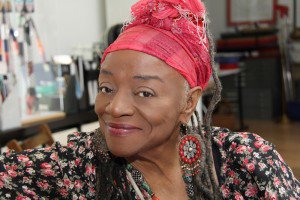Your work is autobiographical, but not always directly, there are characters…
No, it’s from my experience. It’s what I know the best: my experience, who I am, where I am, what I’m doing, what has happened to me. Personally. It’s what has happened to the people around me. So I use all of that to tell my story. And I think that’s what everybody in the world does, everywhere. I travel around the world and look at the work of Africa, Asia, Europe. That art is coming from the experience of the people. You don’t confuse the art of Asia with the art of Africa. It’s there. There’s something there that says “I am who I am” and that is beautiful. The artists, they bring it to you. I can’t wait to see it there at Crystal Bridges. I am looking forward to being there.
Do you come up with a story first or an image?
Well, the first thing, I think, is an idea. And it’s just something I talk about. And then it’s projected into some form of imagery…the formulation of the imagery, the composition. And all of this time I’m drawing and sketching and doing all kinds of color studies, getting my colors together, experimenting with the look of what I’m doing. And then I begin with a painting, with a tighter kind of composition. But I don’t just start, not knowing where I’m going.
How long do you work on it before you get to that stage?
I’m working on several things. I’m working on some things where I know where I’m going and then other things where I’m starting out. And I’ve worked in many media; so I can work all the time, although I’m working on different projects at different stages of development. But I like to keep it going.
So your vision has changed a bit over time. Some of your work in the 60s had violent images, but now they’re much more peaceful.
That was the time. A riot would erupt in a second. You’d be walking down the street and Boom, all of a sudden there would be people running and flying and blood and this and that. And you’d look in the newspaper and it wouldn’t be there. ANYWHERE. No blood shown. No images of the riot. This is the ‘60s, early ‘60s–late ‘50s. And I was fascinated with that. I was there. I saw this. but I’m not getting any of it in the news. A lot of things were just not revealed to us. And I wanted to speak, to show what the times were like: that people would just erupt.
Is that happening again now, do you think?
Oh my God yes, in a way of speaking. I’m not sure how to characterize what is happening in American right now. Some of the old issues, yes, people taking advantage of people because they can. And that is so sad. But not in the way that it was in the ‘60s where it could just erupt and there was basically not a lot anybody could do. Because the information was kept down, not shown, not seen, not known.
So part of your motivation then was to bear witness?
That’s right. And I think that is one of the functions of art. Now, the musicians were telling us. Music of that time was fabulous. The poets were telling us. As an artist, I could show images. And I did. I think art is a lot about truth. I don’t want to lose out on the truth because I’m afraid to declare it.




